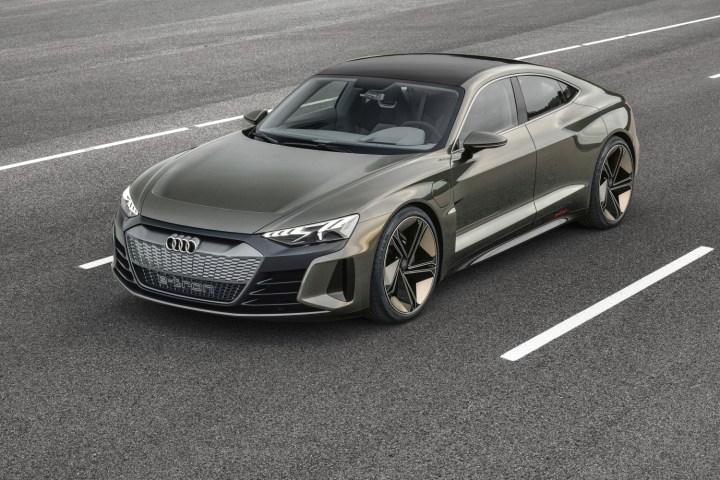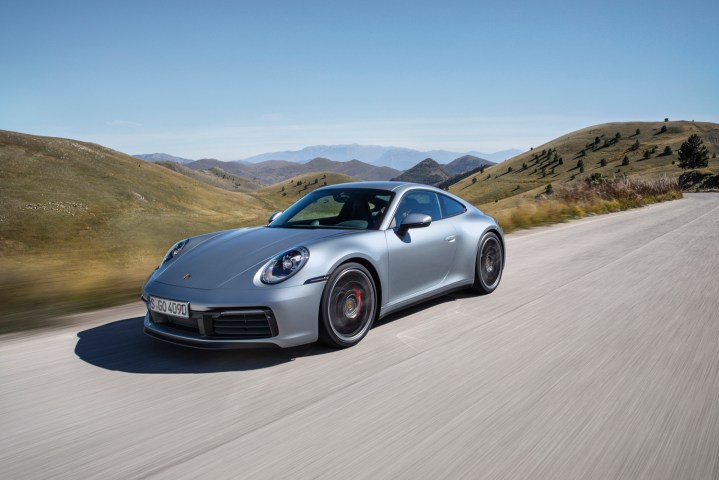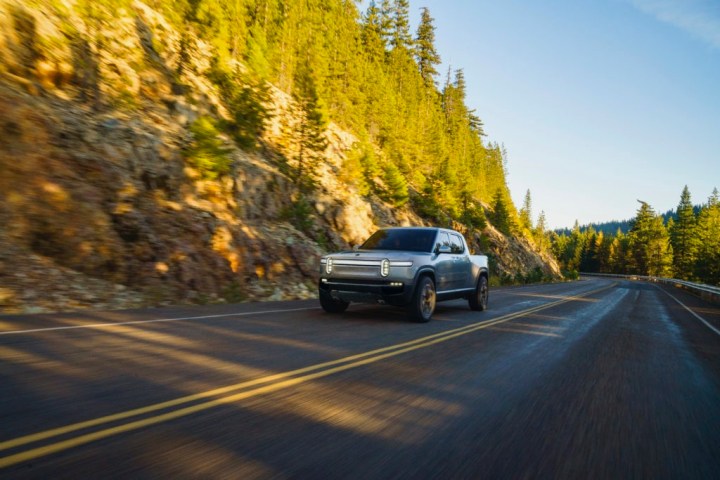The annual Los Angeles Auto Show stands out as one of the most important dates on the automotive calendar. The 2018 edition of the event was bigger than usual because it followed an abnormally quiet Paris show and preceded what’s shaping up to be the smallest Detroit show ever. Car companies from all over the spectrum consequently chose Los Angeles to unveil significant production models and futuristic concept cars.
The Los Angeles show is usually a luxury-oriented event where jet-setter-friendly cars shine under the bright lights. This year, we saw a little bit of everything. The luxury segment was well represented, make no mistake, but we also discovered brand-new trucks, SUVs, and even economy cars. Here are the major product announcements made in Los Angeles by brands like Jeep, Kia, Mazda, Porsche, and newcomer Rivian.
Audi E-Tron GT concept

We’ve often heard rumors of a battery-electric Audi Sport model; this is it. From a design standpoint, the E-Tron GT blazes the path that Audi’s other high-performance electric cars will follow. The interior, like Moby, is 100% vegan and damn proud of it. Audi upholstered the four seats with recycled cloth and cleaned up the planet’s oceans by making the floor mats with discarded fishing nets.
The E-Tron GT is closely related to the upcoming Porsche Taycan under the sheet metal. The two sedans share a basic platform, a 96-kWh lithium-ion battery pack, two electric motors that provide nearly 600 horsepower, and numerous chassis components. These specifications are impressive, but the best part about the GT is that it’s already on its way to production.
“We have never done a show car as close to series production as this,” Enzo Rothfuss, Audi’s head of interior design, told Digital Trends with an unconcealable smile. Marc Lichte, the brand’s charismatic design boss, echoed his comments. That means what you see displayed under the bright lights at the annual Los Angeles show is what you’ll get in showrooms in almost exactly two years’ time
More on the Audi E-Tron GT concept
2020 Jeep Gladiator

Jeep returned to the pickup truck segment it left over a quarter of a century ago. The outdoorsy Gladiator is based on the fourth-generation Wrangler, but its wheelbase is longer and it receives a five-foot cargo box to carry gear and toys. Its natural habitat is a dirt trail miles away from the nearest paved road, not a construction site. Adventurers who want the full Gladiator experience can take off the top, remove the doors, and fold down the windshield. It’s the only truck that doubles as a convertible.
The only engine available at launch will be a 285-horsepower, 3.6-liter V6 that shifts through a standard six-speed manual transmission or an optional eight-speed automatic. Four-wheel drive will come standard; it’s an evolution of the Wrangler, after all. Jeep will add a 3.0-liter turbodiesel V6 to the lineup in 2020. Properly equipped, the Gladiator will be capable of towing 7,650 pounds and hauling 1,600 pounds.
More on the 2020 Jeep Gladiator
2020 Kia Soul

Cue the hamsters; there’s a new Kia Soul on the block.
The third-generation Soul arrived in Los Angeles with a more grown-up design and a smarter, more user-friendly interior. The model retains the boxy proportions that have characterized it since the original version made its debut in 2008. Designers took the front end in a more aggressive direction and fitted the back end with lights that wrap almost all the way around the rear window. It’s a bit of an acquired taste, admittedly.
Kia has always aimed the Soul at a relatively young audience. To keep buyers interested, it has given the interior comprehensive design and technology updates that will keep the model fresh for years to come. There’s an available 10.25-inch touchscreen for Kia’s latest infotainment system, mood lighting, plus an array of electronic driving aids. The gasoline- and electricity-powered drivetrain options return, with the latter getting significant improvements that boost range and usability.
More on the 2020 Kia Soul
2020 Mazda3

Mazda proves a relatively affordable car doesn’t have to look or feel like it’s from the bargain basement. From a design standpoint, the new Mazda3 is a home run. The hatchback variant liberally borrows styling cues from the head-turning Kai concept shown in 2017, meaning it gets a slanted, almost fastback-like roof line that marks a drastic departure from the utilitarian silhouette often seen in this segment. The sedan is more conservative; it’s an elegant evolution of the outgoing model. We hope the 3 drives as good as it looks.
The surprises don’t end at the curvaceous sheet metal. The next-generation Mazda3 inaugurates a fuel-saving breakthrough in engine technology called SkyActiv-X. It’s essentially a gasoline-powered engine that relies on the compression-ignition technology normally found in a diesel. Many car companies have experimented with this solution and failed. Mazda thinks it has cracked the code, and it promises an unprecedented blend of performance and fuel economy. Other powertrain options include gasoline- and diesel engines, and buyers can order all-wheel drive for the first time.
More on the 2020 Mazda3
2020 Porsche 911

We had a better-than-decent idea of what the 2020 Porsche 911 looked like even before it broke cover at the Los Angeles auto show. That’s how emblematic this model has become. The headlights are still oval — no surprises there. Porsche tried to move away from that archetypal styling cue with the 996-generation 911 and fans revolted. It still looks like a 911, too, but the rear lights are now connected by a light bar and the vents on the decklid gets a new-look design that integrates the third brake light. The changes are evolutionary at best, and we wouldn’t have it any other way.
Themuch bigger changes are inside, where Porsche made the cabin more digital than ever before. There is a new screen for the infotainment system, and Porsche updated the instrument cluster with a pair of driver-configurable screens positioned on either side of an analog tachometer. The only model available at launch will be the 911 Carrera S, which gets a turbocharged, 3.0-liter flat-six, but many additional variants will join the lineup in the coming months.
More on the 2020 Porsche 911 Carrera
Rivian R1T

Rather than entering the crowded luxury electric car segment, Rivian boldly aims to apply the Tesla model to the world of off-roaders. The firm currently plans to launch two models called R1T and R1S, respectively. Both will use battery-electric powertrains and offer level three autonomous capabilities. The R1T takes the form of a pickup truck closer to the Honda Ridgeline than to the Ford F-150, but with a design that’s equal parts rugged and futuristic. We haven’t seen the SUV yet.
Rivian’s project brief impresses — at least on paper. The R1T needs to safely drive through 3.6 feet of water, offer over 14 inches of ground clearance, and be capable of climbing 45-degree inclines. If it can achieve these benchmarks, it will, in theory, put a Jeep Wrangler to shame. And that’s just one of its personalities. Rivian promises the truck handles better than a Porsche Cayenne Turbo thanks in part to an air suspension and roll control technology, and it logs a supercar-beating zero-to-60-mph time of 2.8 seconds in its most powerful configuration. It offers up to 450 miles of driving range, too.
More on the Rivian R1T concept
2019 Toyota Corolla

For decades, the Toyota Corolla has been the go-to machine for motorists who want a simple, reliable, and affordable car. It’s also proven to be a remarkably powerful sedative for anyone who seeks even an ounce of driving enjoyment. That’s all about to change, according to Toyota. The newest Corolla falls in line with the company’s attempt at making cars that appeal to the heart, not just the mind. It looks bolder than ever before in recent memory and the firm stresses it will be more enjoyable to drive than the outgoing model.
Interestingly, Toyota will introduce two variants of the Corolla in Los Angeles. The first will get either a 1.8- or a 2.0-liter four-cylinder engine depending on how it’s configured, while the second will receive a fuel-sipping gasoline-electric hybrid powertrain.
More on the 2020 Toyota Corolla
The rest

Luxury car enthusiasts weren’t disappointed by this year’s Los Angeles show. Bentley presented a 626-horsepower, tweed-topped convertible version of the Continental GT. Several recently-unveiled BMW concepts and production cars made their debut at the show, including the X7 and the 8 Series Convertible. Lincoln revealed a new SUV named Aviator which has door chimes produced by the Detroit Symphony Orchestra, while Mercedes-AMG showed us a track-ready evolution of the GT. Honda resurrected the Passport nameplate, and Subaru unveiled a plug-in hybrid variant of the Crosstrek built with a little bit of help from Toyota. Volvo brought nothing at all, but it had plenty to talk about.
Check out our full coverage of the 2018 Los Angeles Auto Show
Editors' Recommendations
- Volkswagen’s electric ID.Life concept car doubles as a gaming console
- New York Auto Show postponed due to coronavirus concerns
- New Hyundai Ioniq electric vehicle gets big boosts in range and horsepower
- Mercedes-Benz’s electric EQC is one of the most affordable cars in its segment
- Lincoln Corsair Grand Touring adds plug-in hybrid power




